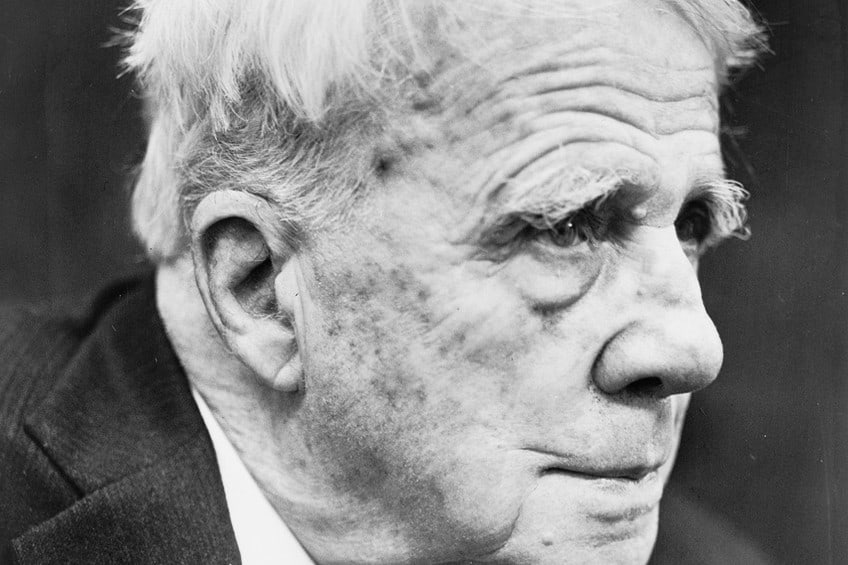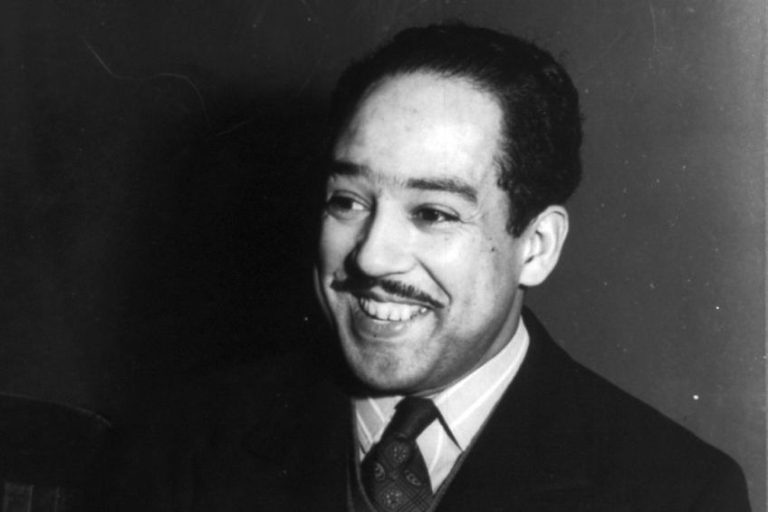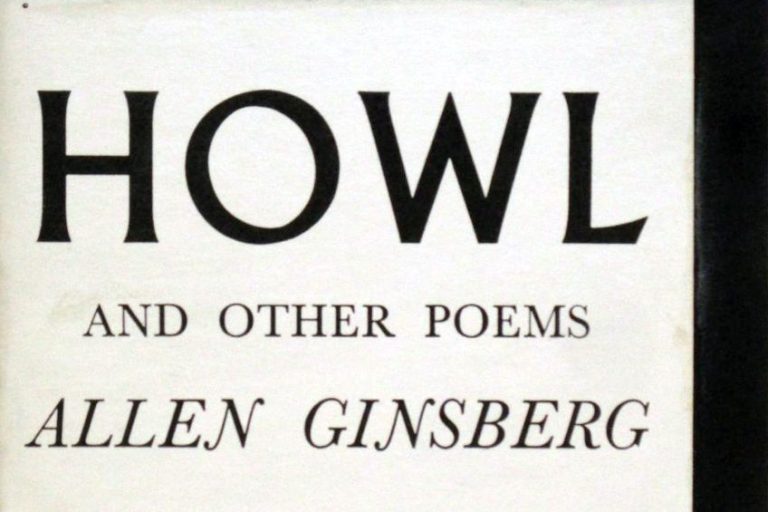“The Road Not Taken” by Robert Frost Analysis – A Quick Summary
The Road Not Taken by Robert Frost is a poem that is at home in practically every high school English class on the planet. This is an iconic 20th-century poem and also a poem that is subject to misinterpretation. This article will serve as an in-depth The Road Not Taken by Robert Frost analysis, alongside a brief biography of the poet and a few The Road Not Taken summary points. So, what type of poem is The Road Not Taken? What is the theme of The Road Not Taken? What is The Road Not Taken rhyme scheme? These are a small selection of questions that we will be answering as you keep reading. Let’s get to that, shall we?
The Road Not Taken by Robert Frost Analysis
| Date Published | 1915 |
| Type of Poem | Narrative poem |
| Rhyme Scheme | ABAAB |
| Meter | Irregular iambic tetrameter |
| Topic | Choices |
The Road Not Taken is one of the most famous American poems of all time and, at the time of writing, it is a few years older than a century. The poem is not all that old in comparison to some of the other most famous poems in the world, but it has become such an integral American poem that it is taught throughout the world. One of the great appeals of this poem is likely the universalism that can be found within it.
The theme of the poem is one that everyone can understand as it is concerned with choices, but we will get to that when we get to the actual analysis of the poem.
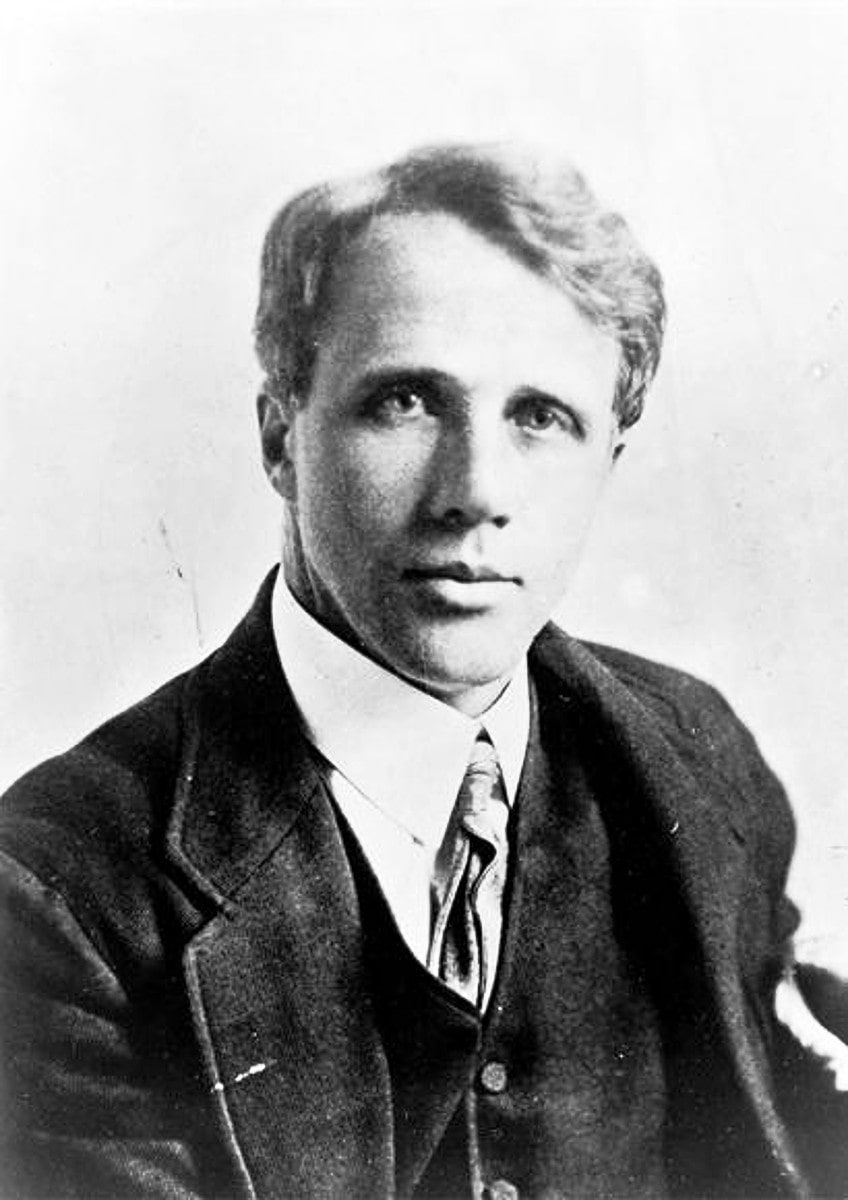
This text first appeared, over a century ago, in the August 1915 issue of Atlantic Monthly. This is a magazine that is still published to this day. Although, it has undergone a name change and is now simply known as The Atlantic. The poem would eventually wind up in one of Robert Frost’s poetry collections.
From there “The Road Not Taken” would become one of the best-known 20th-century poems in the English language.
The Road Not Taken Summary Points
Before we start with our The Road Not Taken by Robert Frost analysis, we should give a brief summary of things for those who may need a few quick points. This is a small selection of The Road Not Taken summary points that may be useful for those who may need to analyze this poem for some or another reason.
- The poem is about choices. This is the central theme around which the poem is presenting itself to us. We are meant to consider that choices are not as easy to identify as we may wish that they are.
- The poem uses a road metaphor. While choices are the central theme that the poem explores, it needs to explore this through certain means, and, in this case, the poem uses the metaphor of a road that has diverged. The two paths that can be chosen on the road represent our possible choices.
- The poem is often misunderstood. While poetry is up for interpretation, many people do misunderstand this poem. The poem does not state that the speaker “chose” the path that was less traveled, but it also draws attention to that supposed correct choice and undermines it by showing that choices can actually be very similar to one another.
And with that, we have concluded our short list of The Road Not Taken summary points. This is only a short list, but it should be somewhat helpful to those who need a summary of this variety. However, if you want to learn a lot more about The Road Not Taken by Robert Frost, then let’s move on from here and instead look at our far more in-depth analysis.
Biography of Robert Frost
| Poetic Movement | American Regionalism |
| Years | 1874 – 1963 |
| Place of Birth | San Francisco, California, United States |
| Known For |
|
Robert Frost is considered to be one of the greatest American poets to have ever lived. He is even considered, by many, to be a quintessential American poet. His work has become known for its depiction of rural American life and was often concerned with the New England landscape. His command of American colloquial speech has made him a mouthpiece for American English and poetry in general.
Over his long career, Robert Frost would go on to become the only poet to have received a total of four Pulitzer Prizes for Poetry.
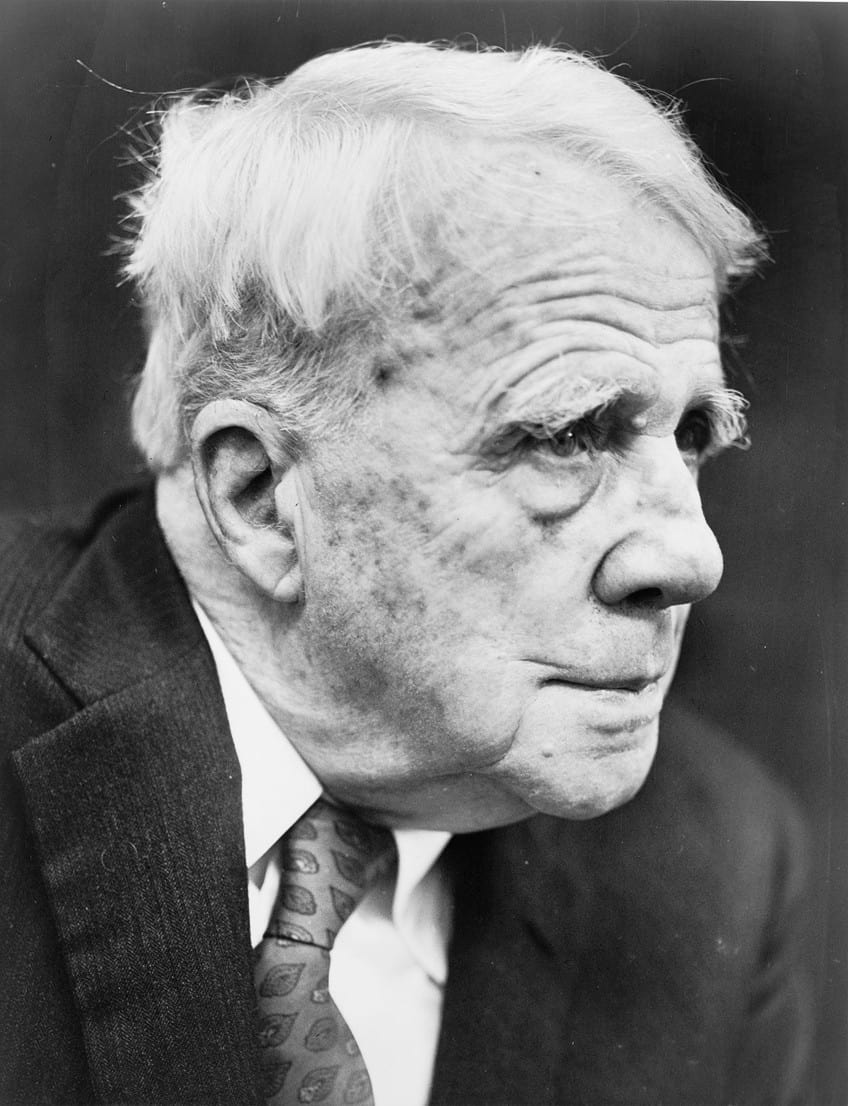
He has essentially become an institution of his own, and he has even won the Congressional Gold Medal for his work. His work is still fondly remembered to this day, and it is often taught in schools around the world. This should help us to understand why The Road Not Taken has become such an iconic example of his work. It’s now time for us to dive into an analysis of this masterpiece of American poetry.
An In-Depth The Road Not Taken by Robert Frost Analysis
The Road Not Taken by Robert Frost is a very famous poem and one that is rather simple in its general design and message, but it’s also one that can be easy to misunderstand. The reason that this is evident is because many have misunderstood the poem’s message. Some of the language is more archaic in its presentation, and this can lead to some confusion about the meaning of the poem, but we are about to commit to an in-depth The Road Not Taken by Robert Frost analysis. So, we need to start with the poem in more general terms before we engage in any stanza-by-stanza analysis.
The Format of The Road Not Taken
It is important to first note the general format of a poem that you wish to analyze. In this case, there are a variety of points to consider. Firstly, what type of poem is The Road Not Taken? This is a narrative poem, and this basically means that it, as the name suggests, has a narrative, or a story, that it tells. This is in juxtaposition to what we often perceive as more “traditional” poems, which tend to deal with thoughts and feelings in a less structured manner than a typical narrative.
So, there is a central character and an inciting action of some kind that this character needs to deal with. As is standard, the central character will simply be referred to as the “speaker” in this analysis.
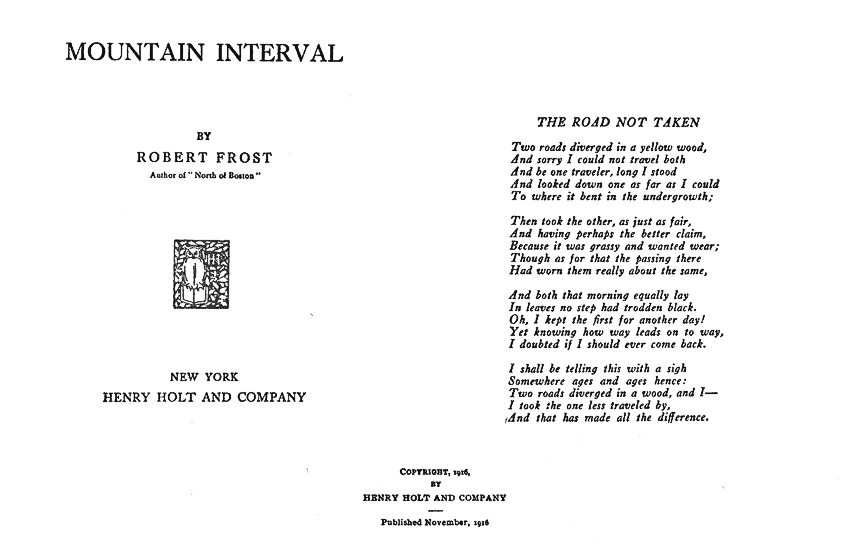 The Road Not Taken, as featured in Mountain Interval (1916); Robert Frost, Public domain, via Wikimedia Commons
The Road Not Taken, as featured in Mountain Interval (1916); Robert Frost, Public domain, via Wikimedia Commons
Next, we may ask ourselves about The Road Not Taken rhyme scheme. In this case, the rhyme scheme is arranged around four quintain stanzas. This means that each stanza is made up of five lines. These five lines each have a repeated rhyme scheme. Specifically, the rhyme scheme is arranged as ABAAB. This means that there are only two rhyming arrangements in each of these stanzas. This also indicates that, in total, there are twenty lines in this poem. This means that it isn’t a particularly long poem, but it isn’t as short as a sonnet.
The poem makes use of an irregular iambic tetrameter structure, and this, along with the use of enjambment, in which lines move into the next without the need for a pause, allows “The Road Not Taken” to have a conversational tone.
All of this backs up the theme of this particular text. So, what is the theme of The Road Not Taken? Well, the theme is choices, but we will need to examine the poem in full before we can truly examine and understand the theme of this poem. So, let’s get underway with our in-depth The Road Not Taken by Robert Frost analysis.
Stanza One
Two roads diverged in a yellow wood,
And sorry I could not travel both
And be one traveler, long I stood
And looked down one as far as I could
To where it bent in the undergrowth;
Before we truly start on our stanza-by-stanza The Road Not Taken by Robert Frost analysis, we need to establish that the poem makes use of a poem-length metaphor. The metaphor here is concerned with the theme. We have already stated that the theme of the poem entails choices, but the primary metaphor through which that theme is explored is the metaphor of a road. There is a road that stretches ahead of the speaker in this poem, and the fork in the road represents a choice that the poet has to make.
If we read this poem in a purely literal sense, it could be about a man walking down a country road and encountering a simple fork in the road, but it goes a lot deeper than this literal meaning. So, it will be best to keep this in mind as we consider this road metaphor that is used.
The very first line opens with the speaker’s choice on the road. It states that the road diverged into two separate paths. The setting of the road is in a “yellow wood”, and this is in keeping with what Robert Frost often wrote. He enjoyed making use of nature imagery when he wrote his poetry, and while this road should be taken as a metaphorical road, if we looked at it literally, we could see it as an actual country road. If this is the case, and the road was an actual, literal road, then the road would still be representative of something greater than the road itself.
The second line states that the speaker is sorry that he could not travel down both of these roads. This is where the idea of choice truly enters the scene. When we generally come across an actual fork in the road, we generally do not worry so much about which path we have taken, but the fact that the subject stood there and worried about which path to choose indicates something deeper about this particular choice. To take one path is to not take the other, and this choice is, therefore, a zero-sum game. If one is taken, the other can never be taken. What should he do? What will he do? What will you do if you come across a road like this?
The third line in this stanza indicates that he waited for a long time before he made his choice. The “long I stood” line is indicative of the wait, and a wait implies something. When we simply choose something quickly and move on, we can be fairly certain that whatever we chose was mostly inconsequential. If we need to make a real decision, a tough decision, we do not necessarily jump onto it with ease. Instead, we sit, and we consider it. We think about it and ponder our other options.
The next line continues this idea. It states that the speaker tried to look down these roads as far as he could see. When we make choices in the real world, or at least when we make choices of consequence, we usually try to think ahead.
Many people are impulsive in this world, and they are the type of people who may not understand The Road Not Taken by Robert Frost, but the rest of us understand. If you have a tough choice to make, you might weigh the pros and cons, you might try to simulate how it would play out in your head, or you might play devil’s advocate between the options available to you. Ultimately though, you need to come to a decision.
In the case of the final line of this stanza, the speaker struggles with this decision. He sees that one of the roads appears to be less-traveled, and filled with more undergrowth. It is “the road less traveled”, which is also how many people describe this particular poem. The decision has been made in the poem at this point, and the next stanza deals with what this choice has meant for the speaker.
Stanza Two
Then took the other, as just as fair,
And having perhaps the better claim,
Because it was grassy and wanted wear;
Though as for that the passing there
Had worn them really about the same,
The second stanza opens with the speaker making his decision. He has taken the “other” that is “just as fair”. This is a little confusing as a statement, and the confusion of it may have led to some of the above-mentioned confusion and misinterpretation that this poem has received from a number of people. Through this The Road Not Taken by Robert Frost analysis, we should be able to parse through some of the harder-to-understand aspects of the poem to figure out what it is trying to say.
The first line, where it states that this chosen path is one that is just as fair, gives way to the second line, in which it states that the chosen road has an even “better claim” to being chosen. It is treated like it is the better choice to have made.
The speaker, here, assures us that the correct path has been taken. The choice that has been made is one that is better. The road taken and the road not taken are binary choices, and the best choice has been made. This is confirmed as the “road less traveled” in the next line.
The third line of this stanza claims that the path the poet took was more “grassy” and “wanted wear”. This implies that the road the speaker chose was the one that was grassier and worn down. It was the unkempt path. It was the path taken by fewer people. It is here where we can find the beginnings of the idea of which path was better to take. However, this better path is one that is subjective.
When it comes to real choices, we are often given the safe choice, or the “path often taken”, or the harder path that is “the road seldom taken”. Do we play it safe? Do we take a chance? Do we gamble with our choices? And, in this stanza, it has thus far been alluded that the more unkempt path was chosen, the one that fewer people walk. The speaker is going his own way! The speaker is not following the ordinary path and doing what is expected of him. Instead, he is forging ahead on his own!
The next two lines bleed into each other because as he was “passing there” and through that chosen path, he thinks about how when he had been at the crossroads, that they were really worn down “about the same”. This is where the confusion appears to enter for many.
Upon first reading this poem, many presume that the speaker made the supposed “right” choice. The right choice, in this case, is the one that is less traveled. We should choose our path and not care about doing as others have done. In fact, we should actively fight against doing things the way that we know others have done similar things. We must do it ourselves!
This line throws all of that into disarray. Only upon choosing what he thought was the “path less traveled” did the speaker consider that the paths had actually looked about the same. The choice between these two was far more similar than he had originally believed. We often think of binary thoughts as being very distinct from one another, but that is not always the case. If you are given a choice between two different types of chocolate ice cream, they are both chocolate ice cream. Simply because there were two options does not mean that the choice was something major.
Stanza Three
And both that morning equally lay
In leaves no step had trodden black.
Oh, I kept the first for another day!
Yet knowing how way leads on to way,
I doubted if I should ever come back.
The third stanza is, perhaps, the one that has contributed to the confusion more than the others as it is a little harder to read and understand. It opens by remembering the path that had opened up before the speaker at the beginning of his journey. The diverging path in the woods had been laid out equally before him. It had appeared like a fresh and new choice that needed to be made, and it had seemed like something very clear-cut and obvious. He had chosen the path less traveled. He had made the choice that we should make if we wish to stand out above and beyond those around us, but the worry has set in at this point.
The second line affirms that the leaves he had seen in the path had not been trodden on, but were they both untrodden? The confusion and difficulty in determining which path had truly been the one that was the least traveled of the two has started to become apparent in the poem.
Before, the speaker had been quite certain of which was the path most often taken and which path was the one less taken. Things have now become more difficult, and this also makes sense. In real life, when we make a choice, we cannot truly know we have made the right choice. Could the other choice have been better? We are not magical beings who are able to gaze backward and forward in time and see the outcomes of choices before they have been made.
The Road Not Taken by Robert Frost tackles this dilemma head-on by confronting us with this reality. Did you make the right choice in doing what you did? Did the speaker in this poem really choose the path less traveled? They may have thought they chose the one less traveled, but did they?
The third line in this stanza reinforces some of the second line’s worries about what now lies behind the speaker. The choice has been made, and the fourth line’s statement that “way leads on to way” implies that the choice leads on to other choices that are made. When you choose one path in the metaphorical road of life, it fundamentally leads to other paths and other choices. There is no solitary decision to be made. Instead, there are multitudinous paths before us. They diverge into an intricate array of crisscrossing decisions, and the final line knows this.
The last line of this stanza states that the speaker doubted if he “should ever come back” to this fork in the road. It may not even be possible to come back to this choice in the future, but we often tell ourselves that we may be able to go back and choose again.
Nothing is set in stone, after all. We are the arbiters of our own existence. Or at least, this is what we tell ourselves. The speaker may think to himself that he could come back, but he knows that he won’t come back. There is no coming back from this.
However, when it comes to choices in the real world, we often define ourselves by them. Choices, and where we wind up in life, is an incredibly important thing. Did you wind up where you were supposed to wind up? No matter what happens, you will always have reached a certain point in life, but could things have been better? Could things have been worse? No matter what, we usually tell ourselves that we made the right choices. We chose correctly, right? We did. Others might not make the right choice, but we made the right decision.
Stanza Four
I shall be telling this with a sigh
Somewhere ages and ages hence:
Two roads diverged in a wood, and I—
I took the one less traveled by,
And that has made all the difference.
We have finally reached the last stanza of The Road Not Taken by Robert Frost. Here, we are confronted with the desire for making the correct choice. The reason is because the poem now looks far ahead into the future. In our lives, we often tell others about our choices, and the first line of this stanza opens with that because he states that he “shall be telling this” story, but “with a sigh”.
The sigh tells us something. When I used to teach this poem to teenagers, I would focus on this part. The speaker does not need to say something like “I’ll pretend that I made the right choice”, instead, what does a sigh signify? A sigh is a resignation. It can be for relief, but it is not in this case.
In this case, when the speaker sighs, he is doing so with something of a mistruth on his lips. He might not be lying at the moment, but he is bending the truth. He is saying what he has been led to believe that he is supposed to say.
The second line states that he will be telling this story far into the future, and the third line is similar to the very first line of the poem as a whole. He reaffirms that he came to two diverging paths in the woods, and he… and there’s a pause. The dash after the “I” indicates a pause. That pause goes with the sigh. The sigh is resignation, and the dash is the pause before the lie. Should he tell the truth? No. He should never tell the truth. He must uphold the myth of our personal decisions.
The second-last line lacks the pause or the sigh as he confidently states that he “took the one less traveled by”. He took the path that fewer people took. It is preferred when we do something like this. We are not meant to simply follow the herd! We are meant to make our own way in this world! We are meant to stand tall and proclaim that our choices in life have been the right ones!
The final line continues the myth. He chose the one less traveled and that “has made all the difference” in his life. However, we know that he is not certain whether or not he even took the path less traveled. He claims he has, but he has also paused, sighed, and considered that the two paths actually looked very similar to one another. This complicates the idea of choice in this poem.
“The Road Not Taken” by Robert Frost is a poem about choices, but it isn’t actually a poem about making the right choice, about making the choice that sets you apart from others, but rather about how choices are unknowable things.
Did we actually make the right choice with what we did? Did we do the right thing? We cannot know because we lack magical powers, as has been stated already. We lack those kinds of abilities. We are not gods. We are simply people, and our choices might have been the right ones, but they also might have been the wrong ones. We will likely never know which. We can only hope that we have made the right ones and then, when we are older and telling the story of our lives, we can try and confidently tell others that we did indeed make the right choices in our lives.
“The Road Not Taken” is likely one of the best-known poems of the last century. This poem is well-known to pretty much anyone who is familiar with English poetry. This is also why we have performed this “The Road Not Taken” by Robert Frost analysis, because it might just be beneficial to a few out there who may need it. However, you may have your own interpretations of aspects of this poem, so what do you think of this text?
Frequently Asked Questions
What Is The Road Not Taken by Robert Frost?
The Road Not Taken is a poem by the noted writer, Robert Frost. The poem has come to be seen as one of the most significant texts of the 20th century. Its immense reach can be seen in the way that the poem can be found in practically every high school English curriculum. The poem is not particularly difficult to read or understand, and it was written in a more conversational style. All of these factors contributed to the poem being widely read and analyzed throughout the world.
Who Was Robert Frost?
Robert Frost was an American poet who was particularly well-known for his regionalist poetry that was strongly focused on rural life in the United States. His work is especially noted for drawing direct inspiration from the New England landscape, and its use of more colloquial language than is often found in poetry. His work has made him a quintessential American poet, and one of the most influential in the country.
What Is The Road Not Taken Rhyme Scheme?
The Road Not Taken is made up of four quintains, or five-line stanzas, and each of these stanzas follows the same basic rhyme scheme. They all use ABAAB. This rhyme scheme means that there are only two rhymes per stanza, and this heavier repetition of the first rhyme aids in the general rhythm of the poem.
What Type of Poem Is The Road Not Taken?
The Road Not Taken is an example of a narrative poem. This type of poem is focused on telling a story, as the name suggests. Narrative poems can be any length and there are no limits on how they can approach their narratives. When we think of poetry, we usually think of it as having a more abstract presentation, such as discussing thoughts, feelings, places, and so on. Narrative poetry, on the other hand, often follows standard narrative conventions, such as having characters, rising action, and a climax.
What Is the Theme of The Road Not Taken?
The Road Not Taken is focused on choices. The metaphor that the poem uses entails a road that forks, and so the speaker in the poem needs to choose between these two roads. They consider the road that they took and, by association, the road that they did not take. The road, and its divergence, is a metaphor for choices at large. How do we approach choices? What do we choose to do? Did we make the right choices? The generalizability of the poem’s theme has contributed to its universal appeal. We can all understand the difficulty that choices pose to us.
Justin van Huyssteen is a freelance writer, novelist, and academic originally from Cape Town, South Africa. At present, he has a bachelor’s degree in English and literary theory and an honor’s degree in literary theory. He is currently working towards his master’s degree in literary theory with a focus on animal studies, critical theory, and semiotics within literature. As a novelist and freelancer, he often writes under the pen name L.C. Lupus.
Justin’s preferred literary movements include modern and postmodern literature with literary fiction and genre fiction like sci-fi, post-apocalyptic, and horror being of particular interest. His academia extends to his interest in prose and narratology. He enjoys analyzing a variety of mediums through a literary lens, such as graphic novels, film, and video games.
Justin is working for artincontext.org as an author and content writer since 2022. He is responsible for all blog posts about architecture, literature and poetry.
Learn more about Justin van Huyssteen and the Art in Context Team.
Cite this Article
Justin, van Huyssteen, ““The Road Not Taken” by Robert Frost Analysis – A Quick Summary.” Art in Context. October 16, 2023. URL: https://artincontext.org/the-road-not-taken-by-robert-frost-analysis/
van Huyssteen, J. (2023, 16 October). “The Road Not Taken” by Robert Frost Analysis – A Quick Summary. Art in Context. https://artincontext.org/the-road-not-taken-by-robert-frost-analysis/
van Huyssteen, Justin. ““The Road Not Taken” by Robert Frost Analysis – A Quick Summary.” Art in Context, October 16, 2023. https://artincontext.org/the-road-not-taken-by-robert-frost-analysis/.


